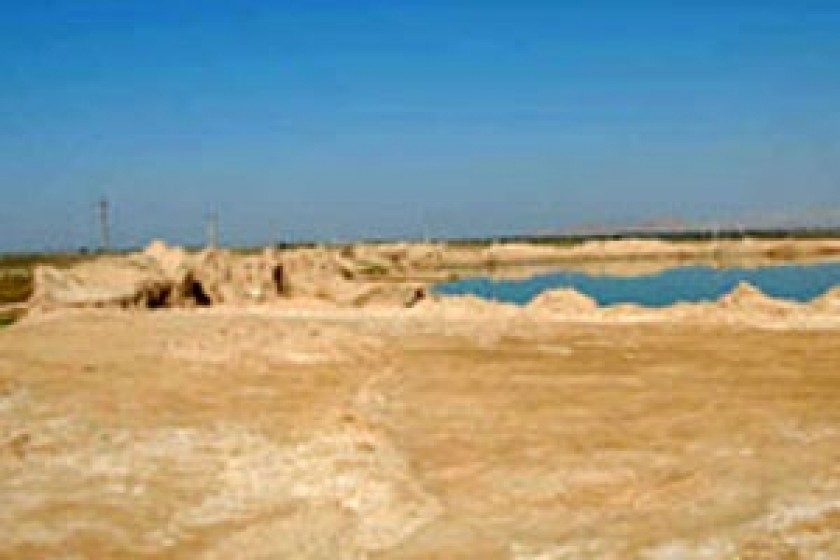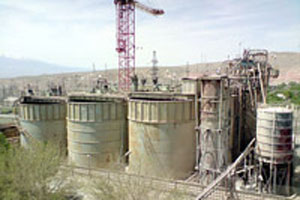
The Gold Rush Leaves Health Problems and Unemployment in its Wake
They are dying silently. The residents of Ararat are struggling to survive next to a tailings dam.
Parallel to the unprecedented growth in the price of gold on the world market there are growing environmental and health problems in the city ofArarat. No matter how much health and environmental specialists claim that it is global factors influencing the local surroundings, that are impossible to counter, the residents of Ararat continue to be concerned with the dangers and the scope of the dangers associated with area industrial concerns.
The local environment falls directly under the influence of the mining industry and gold reprocessing operating there. These operations greatly affect the most vital components that constitute the environment - water, soil, and the air. They also impact on the health of the local residents. Popular opinion is that enough isn’t being done to define the damage being done by local industry. One gets the impression that these dangers are only limited to local residents. Environmental protection laws and decrees remain on paper only. Practically no one in Ararat is informed as to their rights in the matter and what the law states.
During the past several decades there are numerous examples throughout the world showing that, if the proper technologies are utilized, the risks associated with gold reprocessing can be greatly minimized. The Ararat Gold Recovery Company (AGRC) has none of these technologies at its disposal.
The residents of Ararat are finding it increasingly difficult to live in the city. Today they are overcoming many problems just to make ends meet and are constantly struggling against a host of maladies that derive from the gold reprocessing plant there.
Ashot Tzarukyan, a 47 year-old Ararat resident, states, “If I had the means I’d take my wife and kids and leave Ararat today. It’s nearly impossible to battle against all those health problems. The thought constantly haunts me that my girls are being poisoned here, but I don’t have the resources to move.”
Located some 42 kilometers from the capital of Yerevan, the industrial city of Ararat was built in 1931. During the Soviet period a cement factory, a gold extraction plant and other construction equipment operations were erected. The city amassed a host of industrial-related problems including water distribution, waste disposal and other issues associated with shrinking green spaces. The tailings dam at the Ararat gold factory, into which is dumped a liquid soup full of chemical wastes resulting from the ore extraction process, contains a host of materials that pose a risk to the health of the local residents and which negatively impact on the surrounding plant and animal life.
Hakob Sanasaryan, the President of Armenia’s Green Union states, “That tailings dam is full of materials that cause respiratory and blood-related disorders, hereditary diseases and even birth defects. The dam contains cyanides, cadmium, iron and arsenic. According to Emil Babayan, Head of the Industrial Toxicology Laboratory at the Research Institute of General Hygiene and Professional Diseases, at similar facilities materials posing a health risk are separated out during the production process. Mr. Babayan states, “Silicosis, for instance, is an ‘industrial’ disease resulting from the inhalation of crystalline silica dust. There are also many diseases afflicting the male sexual organs associated with the presence of lead and molybdenum.”
On November 13, 2007, fifty residents of Ararat participated in a survey to ascertain what percentage of them understood the risks posed by the tailings dam to their health and to the environment and to see what they thought about the issue.
 100% of those responding were aware that the gold factory’s tailings dam, located just outside the city limits, contained materials posing a health risk. They also knew that those materials presented a danger to animals and plants. When asked if they knew the names of the hazardous materials collected in the dam the residents answered - cyanide.
100% of those responding were aware that the gold factory’s tailings dam, located just outside the city limits, contained materials posing a health risk. They also knew that those materials presented a danger to animals and plants. When asked if they knew the names of the hazardous materials collected in the dam the residents answered - cyanide.
Local residents however didn’t know about the existence of the other, equally dangerous materials being stored there; materials that have caused birth defects in the Province of Lori, rife with industrial plants.
Hakop Sanasaryan notes that, “People have forgotten about the real danger and talk about other materials. There are materials even more dangerous than cyanide that factory management skillfully avoids talking about. While of course lead and molybdenum, in certain quantities, are of benefit to plants and animals, overexposure proves fatal to 92% of the soil’s fertility.”
Doctors at the city’s only hospital didn’t wish to be interviewed but they stated that the toxic materials accumulating in the tailings dam did indeed cause a host of serious health problems. According to the statistics they provided during the past four years there was a rise in cancer-related diseases in Ararat, from 211 cases in 2004 to 290 cases in 2007. They added that these were just the official statistics and that there are definitely other cases never reported.
The doctors also stated that during the past 10 years there have been no medical examinations conducted by either the factory owners or the ROA Ministry of Nature Protection. The physicians noted that such examinations must be compulsory in order to diagnose the illnesses in time.
During the course of the survey mentioned it became apparent that city residents didn’t put much trust in their doctors. Garen Vardanyan, a 33 year-old Ararat resident who works as a cab driver, states, “The doctors have cut a deal with that factory and that’s why none of them speak the truth or register all medical cases. The doctors have underlined what maladies these materials can cause in theoretical terms but they refuse to take serious steps and state that this business has a dark side that immediately impacts our health.”
The condition of the city’s residents proves that in Ararat all are afflicted, from the newly born to the elderly. Armen Ginosyan, an enterprising 36 year-old stated, “I took my wife to Yerevan when she was due to give birth since the staff here were still performing post-mortems.”
We should add that during our interview Ararat Mayor Abraham Babayan proudly noted that a magnificent morgue had been built.
According to statistics of the Ministry of Nature Protection’s Monitoring Center, “Outside the capital the levels of certain chemical elements and particulates surpass permissible standards especially in the cities of Ararat, Alaverdi and Kajaran.”
The Center states that in Alaverdi, where a copper foundry operates in 2001 there were 679 registered cases of children under the age of fourteen with respiratory diseases and 1,239 cases in 2003.
The main issue of concern for the residents of Kajaran is the chronic cough that afflicts most all in the town where a copper-molybdenum factory operates.
What differentiates these industrial cities is the specific production process in operation. The complaint of the Ararat townsfolk however isn’t limited to the gold recovery plant. They are equally concerned about the dust produced by the cement factory.
Mr. A. Ginosyan states, “From an environmental perspective the situation of the city is pretty bad. The cyanide and cement produced greatly impacts on our health, the birthrate and animal life.”
The city of Ararat is overwhelmed with a number of health issues that the specialists claim can be seen with the naked eye. Mr. Philip Pek, an Australian specialist sent to Armenia to teach a course in environmental journalism organized by the United Nations Environmental Program (UNEP/GRID-Arendal) that took place in Yerevan in November 2007 stated, “The cement factory is truly an environmental crime alongside the others. It emits large quantities of particles into the atmosphere that will have serious negative impacts on the health of the local residents.”
If the threat posed by the tailings dam must be explained to some, the dust plumes emitted by the cement factory are in plain sight to all. The dust that belches out of the factory pipe is a mixture of cement particles and water vapor. In theory, the steam is supposed to quickly break down in the atmosphere but this isn’t the case. Black particles of cement can be seen floating in the air above for quite some time before falling back to the surface and covering the town below.
 Videos
Videos Photos
Photos




Write a comment